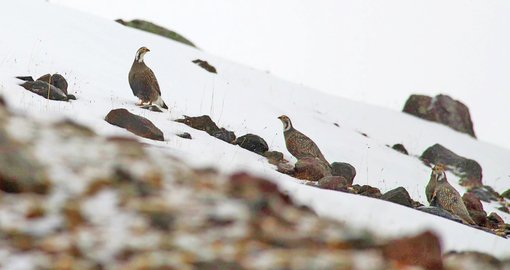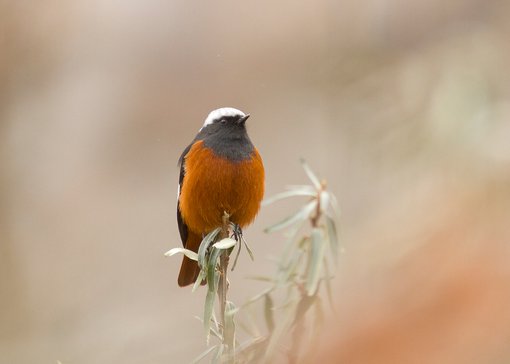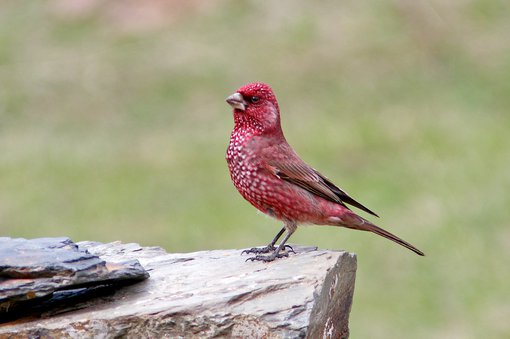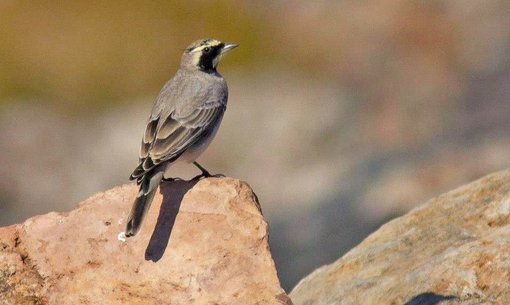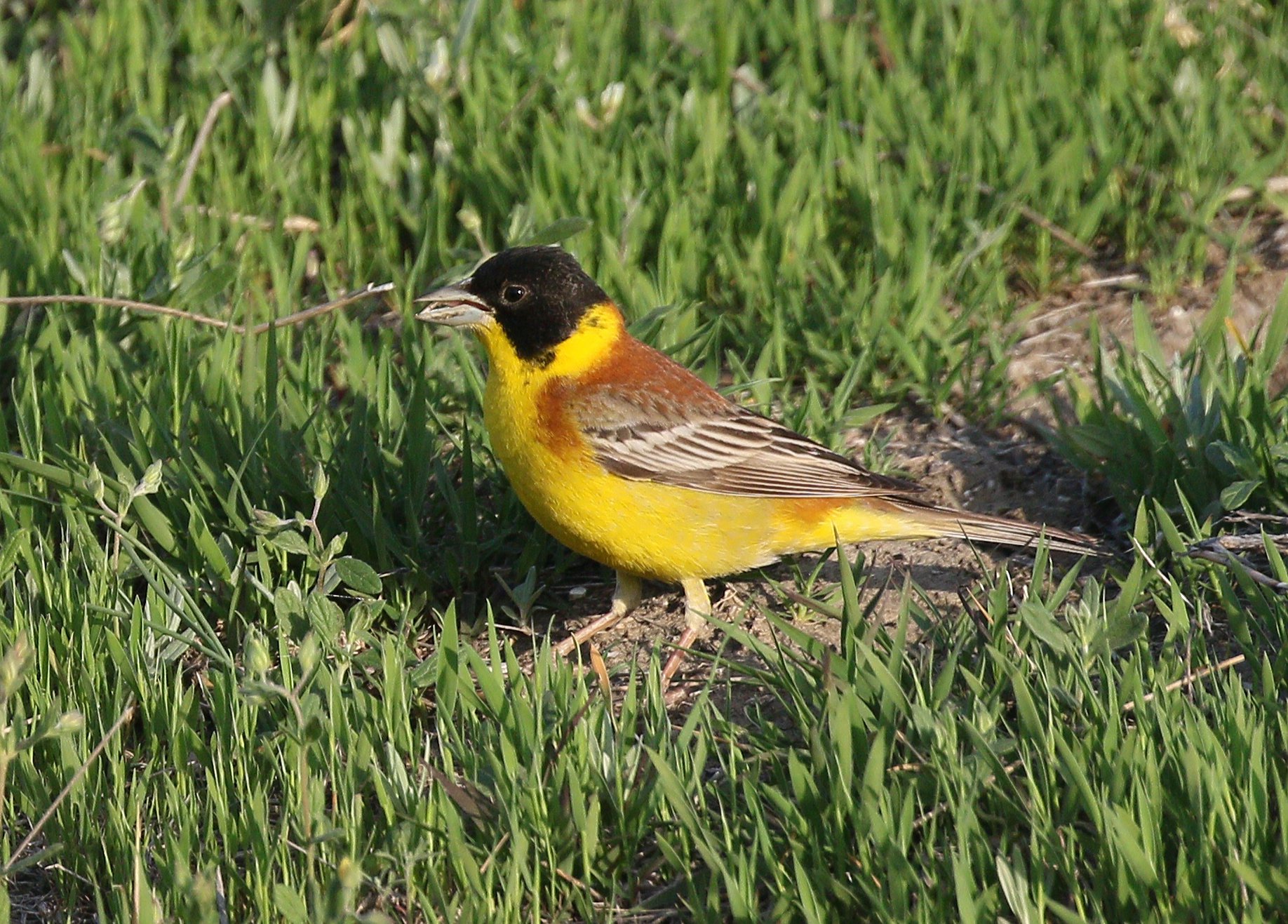Georgia
Edge Of Europe
A 9-day small group birdwatching tour to Georgia looking for Western Palearctic specialities including Caucasian Snowcock, Caucasian Grouse, Güldenstädt’s Redstart and Great Rosefinch
Among European birds, there are a special few that attain near-mythical status, for they occur only at the outermost reaches of the Western Palearctic region. Caucasian Snowcock, Caucasian Grouse, Güldenstädt’s Redstart and Great Rosefinch are all names to conjure with and our Georgia birding tour has chances of all four!
Now with an improved itinerary, Limosa’s April birdwatching tour to Georgia (which is run in association with our sister brand, WildWings) is timed to coincide with the best time to look for these specialities plus so much more along the way! Join us as we return to bird at the 'edge of Europe' and enjoy the spectacularly scenic mountains of the High Caucasus, the rolling Iori plains and some fantastic birds.
Tour Dates & Prices
Tour Highlights
- Birding at the extreme easternmost ‘edge of Europe’ for sought-after Western Palearctic specialities
- Caucasian Snowcock and Caucasian Grouse in the spectacular High Caucasus Mountains
- Güldenstädt’s Redstarts and Great Rosefinches to look for on the edge of town
- Lammergeier, Wallcreeper and Red-fronted Serin in the mountains
- Mountain Chiffchaff, Ménétries’s, Barred and Green Warblers, Semicollared Flycatcher
- Demoiselle Crane, Isabelline Wheatear, Rosy Starling and Black-headed Buntings on the steppe
- Small group tour with a maximum of 10 participants
- Expertly led by a leading English-speaking Georgian bird guide and (subject to minimum numbers) Limosa's John McLoughlin
Outline Itinerary
Fly from the UK to Tbilisi.
Arrive in Tiblisi. Head north into the Caucasus Mountains for Güldenstädt’s Redstart and Great Rosefinch. Night Stepantsminda
Snowcock, grouse and more upland specialities of the High Caucasus. Stepantsminda (2 nights)
Early morning birding at Stepantsminda, travel east via Tbilisi Reservoir. Night Signagi
Exploring the Iori Uplands for Demoiselle Crane, Ménétries’s Warbler and eastern Mediterranean species. Signagi (2 nights)
Birding on our way back to Tbilisi. Night Tbilisi
Fly Tbilisi to the UK

Following the outstanding success of our previous tours, we are thrilled to be travelling to Georgia again in 2024 in association with our sister brand, WildWings. It is such an exciting destination to travel to, with largely unspoilt landscapes and some amazing bird life. Additionally, we have tweaked our itinerary so we now have fewer changes of hotel and better timed flights, thus allowing for more time birding, especially in the productive southeast.
North of Tbilisi, at the end of the old Russian highway, lie the High Caucasus mountains that straddle the border between Europe and Asia. Set amidst some of the highest peaks on the continent – five of which rise above 5,000m (16,000ft) - lies the town of Stepantsminda, scenically situated below glacier-clad Mount Kazbeg. This developing town is an excellent base from which to explore the region and to search for four near-mythical birds that occur at the easternmost edge of the continent. Merely mention of their names is enough to get the birding juices flowing: Caucasian Snowcock, Caucasian Grouse, Great Rosefinch and Güldenstädt’s Redstart. Georgia, now opening up to tourism, gives the best chance to see all four and this exciting early spring tour amidst the rich montane landscapes of the High Caucasus range is timed to catch them before they follow the retreating snow line higher and deeper into the inaccessible mountains.
From our conveniently located hotel, the hills are but a stone’s throw away and we start early for two of the key targets as it is at this time that Caucasian Grouse perform their lek on grassy slopes and Caucasian Snowcocks give their presence away with their haunting, diver-like calls high above. Patches of buckthorn are places to search for gorgeous crimson male Great Rosefinches and handsome white-capped Güldenstädt’s Redstarts. With three days to explore this fascinating mountain region, we have a great opportunity to see all four of these localised specialities against the fantastic backdrop of Mount Kazbek.
Our tour is designed to run at the best time of the year to find the redstart and rosefinch before they return to higher elevations for the summer. Hoping to catch the snowmelt just right, we hope to find other high-altitude species before they too return to the higher mountains.
On rockier pastures from which they pick on seed heads, Red-fronted Serins hop about the boulders and Mountain Chiffchaffs sing from budding trees. On basalt cliffs, Wallcreepers flutter around like outsize butterflies, flashing crimson, black and white wings, whilst Lammergeiers soar high above accompanied by passing raptors. Ring Ouzels of the distinctive white-winged form amicorum and Common Redstarts of the samamisicus race (Ehrenberg’s Redstart) are both extremely attractive and well worth catching up with. The mountain passes also act as pathways for migrants heading through the Caucasus range and on into Russia and we can expect to find passerines such as Red-breasted and Semicollared Flycatchers, Yellow Wagtails and Red-throated Pipits as they head north to breed.
Reluctantly dragging ourselves away from the mountains, we return south via Tbilisi, pausing to check a large reservoir (locally known as the ‘Tbilisi Sea’) for Armenian Gulls and marsh terns, before swinging east to Signagi and a very different environment.
With the snow-capped mountains still visible to the north, the warm, rolling steppe and hills of the Iori Uplands that lie to the east of the capital attract a very different range of birds. Elegant, rainbow coloured Bee-eaters 'prruup' and swoop, and chestnut-backed Rollers flash ultramarine blue wings in display, while scratchy Ménétries’s and melodious Barred Warblers sing from the bushes. Black Francolin utter their grating calls and a wealth of wheatears feed on beetles, with Isabelline and smartly dressed Pied and Eastern Black-eared (as well as many hybrids between the two) to look for. Woodchat Shrikes are followed by Eastern Orphean Warblers and Rosy Starlings should just be arriving to breed.
Amidst a landscape inhabited by Golden Jackals and Wolves (although both are only rarely seen), where prominent trees act as perches for vultures, the grassland rings to the spring songs of Calandra, Crested and Short-toed Larks and the simple phrases of black and yellow Black-headed Buntings. Montagu’s Harriers are a common sight as they float across the flowering grasslands and Eastern Imperial Eagles will be nesting. Exploring lines of trees and verdant streambeds we will also hope to come across a surprise migrant or two…
Our April 2024 tour to ‘the edge of Europe’ will be led by an expert English speaking Georgian bird guide and, subject to minimum numbers, will also be accompanied by Limosa guide John McLoughlin.
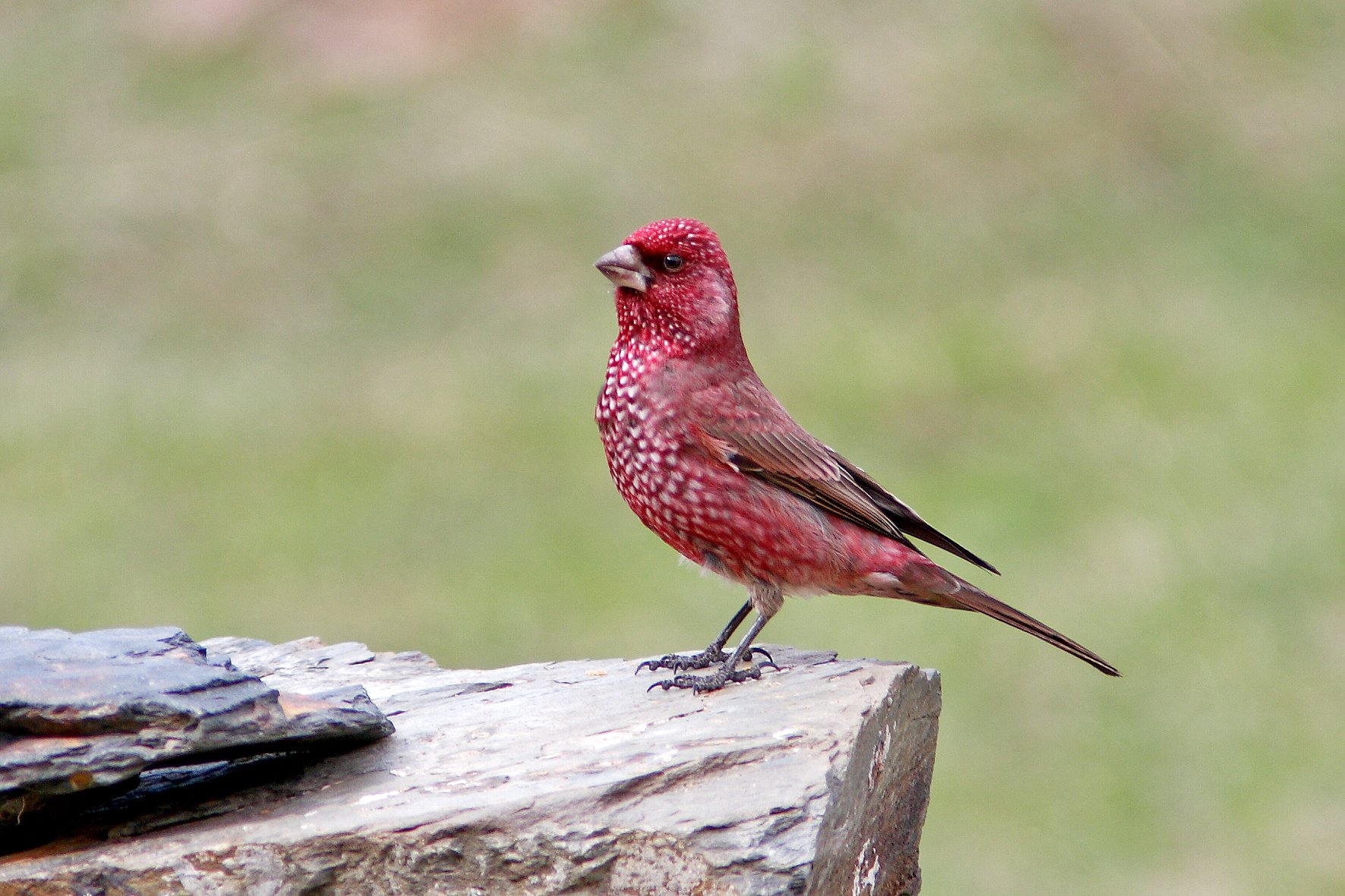
DAY 1: FLY UK TO TIBILISI
DAY 2: TRANSFER TO THE CAUCASUS MOUNTAINS
Our spring birdwatching tour to Georgia tour starts with our arrival in Tbilisi where we will be met by our local guide and our adventure begins! We will leave Tiblisi and head north towards the magnificent mountains of the Greater Caucasus that loom ever larger in our view as we get closer. We will stop along the way to enjoy anything of interest and as we begin to climb higher, we will pause at Ananuri, where migrant birds rest in the foothills which are cloaked in oak and beech forest. In fine spring weather, vocal Green Warblers, and perhaps singing Red-breasted or Semicollared Flycatchers should be present and around a nearby monastery, parties of migrant Ortolan Buntings or Whinchats often gather.
Our destination is the upland town of Stepantsminda, nestled in the Tergi Valley and dominated by the snow-capped mountains of the High Caucasus - notably that of Mount Kazbeg, which at just over 5,000m (16,400ft) is one of the highest peaks in Europe.
Following lunch, we arrive at our comfortable hotel and then have our first chance to explore this interesting town. A wealth of birds await as we set out for a local patch of budding buckthorn, hoping to pick up our first Güldenstädt’s Redstart and Great Rosefinch! High above, we may well see our first birds of prey spiralling over the mountains. Night Stepantsminda
DAYS 3 - 4: STEPANTSMINDA & THE CAUCASUS
Rising early, we have our first chance before breakfast for two of the ‘star’ birds of the tour: Caucasian Grouse and Caucasian Snowcock. It is important to get out close to dawn, as these shy grouse are most active during the first hours of daylight and soon disappear as the sun rises.
The snowcock sit high above the grassy slopes and we should hear their eerie, diver-like calls echoing about the valley. Caucasian Grouse, a lyre-tailed and all-black relative of the Black Grouse, strut about on lower slopes and are generally easier to find. If we didn't manage to spot one yesterday, we also have a further opportunity to look for Great Rosefinch – the gorgeous males' deep crimson bodies flecked with white. Hopefully, we will return for breakfast well and truly ‘full’ of birds!
After breakfast, a stroll around town may reward us with more good species with the possibilities including a variety of migrants or ‘seconds’ of Great Rosefinch and the snow-capped Güldenstädt’s Redstart. This region is the only location within the Western Palearctic that offers a chance of seeing these birds, so we will spend some time checking for them all.
With Stepantsminda as our base for three nights, we can also explore the spectacular and winding roads that lead to the higher passes.
South at the Truso Valley, we should encounter a number of mountain birds, with tame flocks of Twite (of the race brevirostris), Shore Lark (race penicillata) and White-winged Snowfinches (here of the paler race alpicola) feeding beside the road and often giving excellent photographic opportunities.
As we scan the slopes, we should find Golden Eagle, Griffon Vulture and Lammergeier above a hill top. Small parties of the stunning, black and 'red-polled' Red-fronted Serin can be found amongst the boulders and crimson-winged Wallcreepers flutter about the sheer rock faces, while squadrons of Red-billed and Alpine Choughs wheel above. ‘White-winged’ Ring Ouzels of the amicorum race are a sight to behold and other ‘montane specials’ include Alpine Accentor, the abundant Caucasian Water Pipit (race coutellii), Northern Wheatear and Black Redstart.
If conditions are right, this region is a flyway for raptors heading north into the vastness of Russia. Northern Goshawk and Steppe Buzzard, plus Steppe Eagle, Montagu’s and Pallid Harriers, and the season's first Red-footed Falcons could well be passing through the valleys at this time. Ortolan Buntings, Bluethroats and Barred Warblers can also be seen, while various races of Yellow Wagtails and Arctic-bound Red-throated Pipits feed in grassy fields. Mountain Chiffchaff is common here and often calls from the birches about the hotel and we will take our time exploring the small copses, where we hope to see a fine Semicollared or Red-breasted Flycatcher.
There are a number of interesting mammals in the region, such as East Caucasian Taur and Chamois and if we are incredibly fortunate, Eurasian Wolf and Brown Bear are very occasionally seen up here. Two further nights Stepantsminda
DAY 5: STEPANTSMINDA TO SIGNAGI
This morning we will make the most of our time in the mountains and get out early for one final chance to enjoy the snowcock or grouse.
After breakfast, we may check once more for migrants or try for Alpine Accentor or White-winged Snowfinch as we head over Jvari Pass or stop at the peace monument at Gudauri.
We will break for coffee or lunch near Ananuri, where the fortress and surrounding trees can hold smart, white-winged samamisicus Common Redstarts – often known as ‘Ehrenburg’s Redstart’ and a potential split. Semicollared Flycatchers, Red-backed Shrikes, Barred Warblers and Ortolan Buntings are among other possible highlights to be found here in spring.
To the northeast of Tbilisi lies a large reservoir (known locally as the ‘Tbilisi Sea’), where non-breeding Armenian Gulls over-summer. We will drop by to look for them and hopefully also find migrant terns such as Gull-billed or White-winged feeding over the lake.
Continuing eastwards, the landscape changes as we enter a region of open and richly coloured rolling fields, with lines of vines amidst blood-red poppies. The birdlife changes too, and we should soon begin to see Long-legged Buzzards, Nightingales and hundreds of Corn Buntings singing their distinctive jangling song.
Arriving to Signagi in the late afternoon, we may have time to explore the area about the hotel - our home for three nights. Night Signagi
DAYS 6 - 7: IORI UPLANDS AND CHACHUNA
The Iori Uplands are a line of hills set amidst Georgia’s rolling grass plains and incised by several gorges. Towns and hotels are few and far between in this far-flung, lightly populated corner of Europe, but at Signagi we are well placed to explore this tucked away land. Birds typical of this region include Green and Barred Warblers, Golden Oriole, Hoopoe, Woodlark, Red-backed Shrike, Nightingale and Rock Sparrow.
From Signagi, we will head southeast and visit the lake near Dedoplistskaro, checking for birds such as Lesser Spotted Eagle and Black Vulture. Perhaps the water’s edge will be adorned by Black-winged Stilts or Ruddy Shelducks, whilst Bee-eaters pass by and Rollers perch on isolated trees. Yet more Corn Buntings chase about and Quails call (invariably unseen!) from the fields.
A little to the north lies Eagle Gorge Natural Monument, where Egyptian Vulture and Black Stork may be breeding. A late afternoon walk here should produce Booted and Lesser Spotted Eagles, or maybe even an Eastern Imperial Eagle. Alpine Swifts fly over the limestone crags and this area also harbours some superb wildflowers and a few early butterflies.
We will also enjoy one long but outstanding day trip from Signagi to the Chachuna Managed Reserve. The open steppe along the way can produce many great birds and often starts with an exultation of larks, including Calandra, Greater Short-toed and Lesser Short-toed. Rock Sparrows call wheezily and Little Owls should be looked for perched on small stones. Hoopoes and elegant Demoiselle Cranes may be found amidst the poppy studded hillsides, where Eastern Imperial Eagles breed. As the habitat becomes drier, Isabelline Wheatears and Woodchat Shrikes become increasingly common, the former already feeding well-grown young.
At the Dali Reservoir, specialities such as Black Francolin, Chukar, Ménétries’s Warbler and Eastern Orphean Warbler could well be found in the scrub below the dam. Penduline Tits call from the reeds and pools can hold Kingfisher, while the trees may reveal Green Woodpecker - looking somewhat incongruous out here on the steppe! A small colony of Lesser Kestrels wheels about an old dam building, usually giving fine views.
All the while, Egyptian, Black and Griffon Vultures soar overhead and the noisy flocks of incoming Rosy Starlings - newly arrived from their winter quarters in India - are a joy to watch as they chase after grasshoppers or sing from bushes. Two further nights Signagi
DAY 8: RETURN TO TBILISI VIA DAVID GAREJI
With the whole day to travel back west to Tbilisi, we will take our time today, perhaps visiting a breeding spot for Semicollared Flycatchers near Kakheti or investigating the shores of Kopaditze Lake before diverting south to the monastery at David Gareja which is another superb area of open steppe and hillside birding, close to the border with Azerbaijan.
Raptors often drift above the open landscape with the possibilities including Saker Falcon and Pallid Harrier. Today will also be our last opportunity to spot migrating Demoiselle Cranes which pause here on their long journey north, before crossing over the high mountains.
The scrubby, rocky slopes beside the monastery at David Gareja could well provide us with our best chance of finding Pied Wheatear amidst the numerous hybrids and Eastern Black-eareds, while Ortolan Buntings sing from the bushes. Blue Rock Thrushes can be found here too, and migrants such as Eastern Orphean Warbler and Lesser Grey Shrike sing as Bee-eaters pass over the fascinating rock formations.
As we arrive back in Tbilisi for our final night, we will take our evening meal at a typical Georgian restaurant, where we can sample some local dishes and also enjoy a glass of one (or more!) of the fine wines for which the country is rightly proud. Night Tbilisi
DAY 9: FLY TBILISI TO UK
We depart Tbilisi in the early morning for our flight back to London, where our spring birdwatching tour to Georgia concludes.

WHAT TO EXPECT
Our tour to Georgia and the High Caucasus is timed to start in the second half of April, when the mountains are accessible but there is still a good chance of lying snow which means the high mountain specialities are at lower elevations allowing us to find them! Though we have chosen the optimum period to visit, if the weather has been unseasonably warm, please note that Great Rosefinch and Güldenstädt’s Redstart can head higher into the mountains early and so can occasionally be missed.
Birding in the High Caucasus Mountains will require some physical effort, so a reasonable degree of fitness is required for this tour. We will be spending most of our time here at altitudes of around 1,900-2,200m (6,200-7,200ft), although, depending on snow conditions at the time of our visit, we may reach 2,500-3,000m (8,200-9,800ft).
We shall be birding at lower elevations, around 300-800m (1,000-2,600ft), in the hills and steppe around Signagi and Dedoplistskaro in the southeast and the weather there will be warm to hot.
We shall naturally want to make the most of our days at the peak of early morning bird activity, so on this tour please note we will be starting early each day (around 6.00am) with optional early birding, returning for a sit-down breakfast (around 8.00am).
Our itinerary for 2024, this tour involves only three longish drives: Tbilisi north to Stepantsminda on Day 2 (approx. 3 hours); from Stepantsminda south and east to Signagi on Day 5 (c.5 hours); and from Signagi back to Tbilisi on Day 8 (approx. 3 hrs) although on all of these days, we shall stop along the way for birding and lunch.
The drive from Signagi to Dedoplistskaro takes about 45 minutes, from where our journey out to the reservoir near Chachuna is slow as we have to drive a 30km track. This is terrific for birding and we will stop regularly but please note that the going here will be rough and bumpy.
We will experience a difference in climate between the two different regions we visit. In the high mountains, the weather in late April is usually cold-cool and changeable, and with the winter snows beginning to melt. Daytime temperatures will typically vary from 5-15°C (41-59F), but drop quickly at night.
The southeastern steppes of the Iori Uplands in April average rather warmer, with daytime temperatures typically in the range of 13-26°C (55-79F) and periods of sunny skies and more overcast or rainy conditions and it can feel cool, especially at night.
There is a high chance of some precipitation on this tour and whilst this is most likely to fall as rain, snow is still possible in the mountains.
BIRDS
150-180 species
MAMMALS
5-10 species
ACCOMMODATION
Seven nights accommodation in Georgia, where we stay in a modern hotel at Tbilisi and in smaller, more simple yet comfortable hotels at Stepantsminda in the Caucasus Mountains (3 nights), and at Signagi (3 nights) in the Iori Uplands of the remote southeast.
MEALS
All main meals are included in the tour price, commencing with dinner on arrival in Georgia on the evening of Day 1 and concluding with lunch in Tbilisi on Day 8.
Most lunches will be sit-down meals at a local restaurant, with a packed lunch on our day at Chachuna. Continental-style breakfasts. Evening meals at the hotels tend to be simple but filling.
WALKING
Easy to moderate walking on this tour, although some uphill walking is inevitable in the mountains, although precisely what we do and where we go is dependent upon weather conditions at the time as well as the snowline.
Wear sturdy waterproof walking shoes or boots with stout corrugated soles for good grip. We will be taking things slowly with plenty of time for breaks.
TRAVEL
Despite the end of pandemic restrictions, we have taken the decision to continue to price our holidays as excluding international flights.
To keep the process as simple as possible, we are working very closely with a dedicated agent at Travel Counsellors, Sacha Barbato, who is essentially now our “in house” flight consultant.
Sacha will be able to advise you which flights we are recommending for each holiday, and he will be able to book these for you.
This will also sometimes give you the option to travel from a regional airport if you prefer.
GROUND TRANSPORT
Minibus with local driver or other suitable vehicle depending on group size.
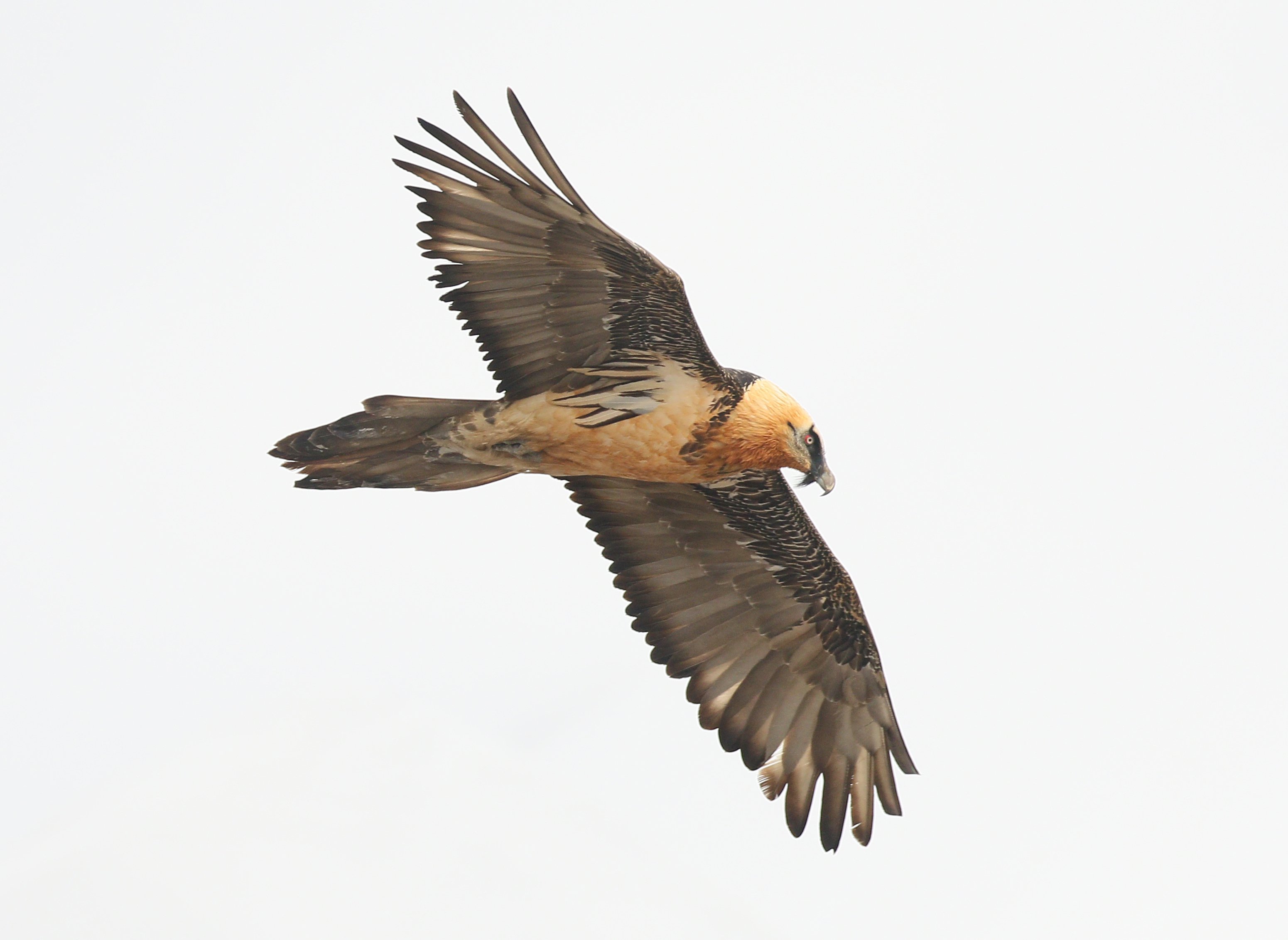
Tour Gallery
View a gallery of images for this tour below, click on an image to view as full size with caption
